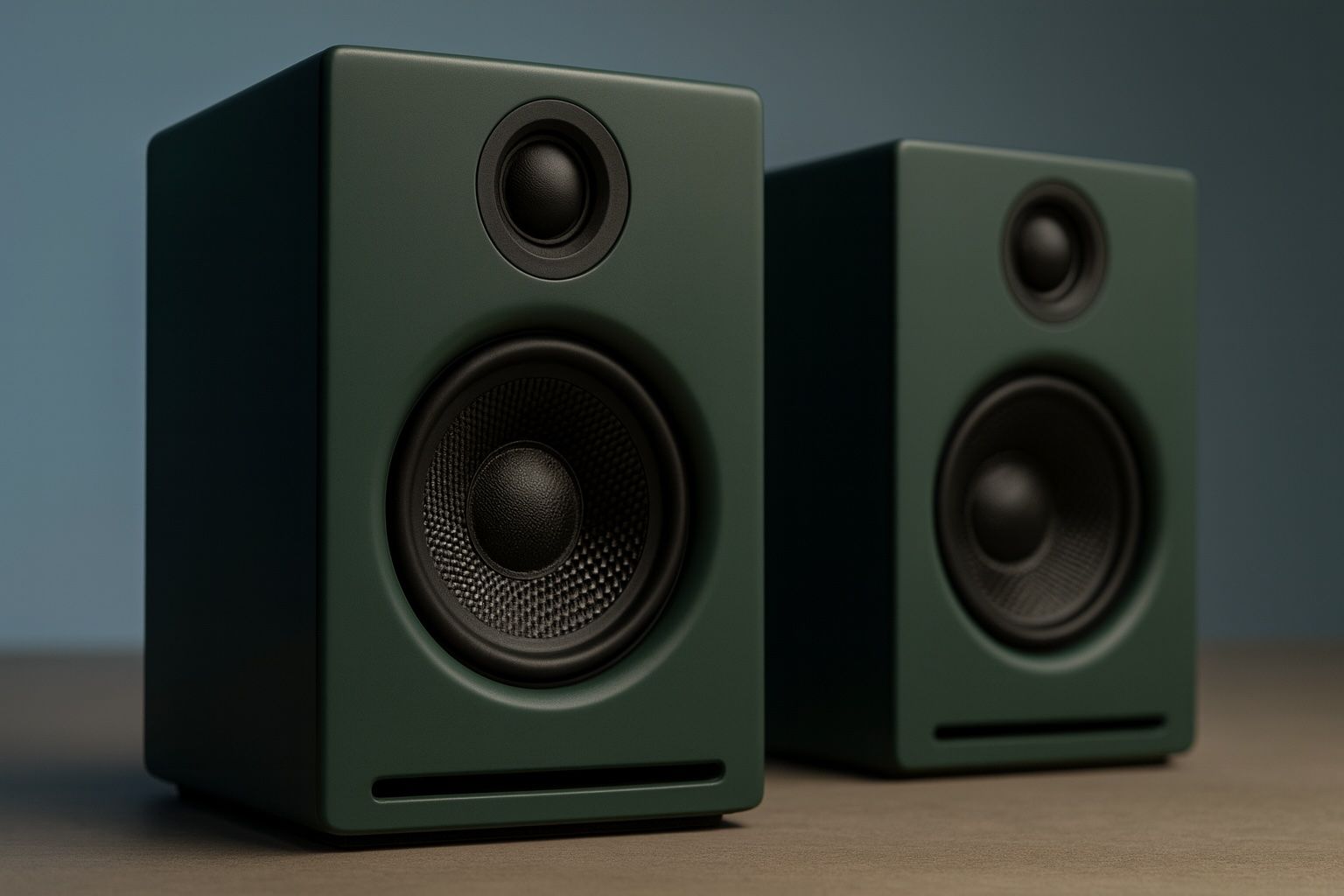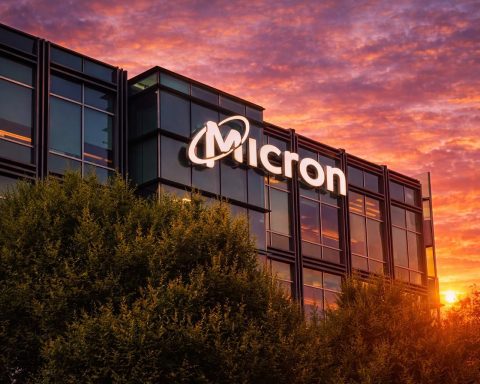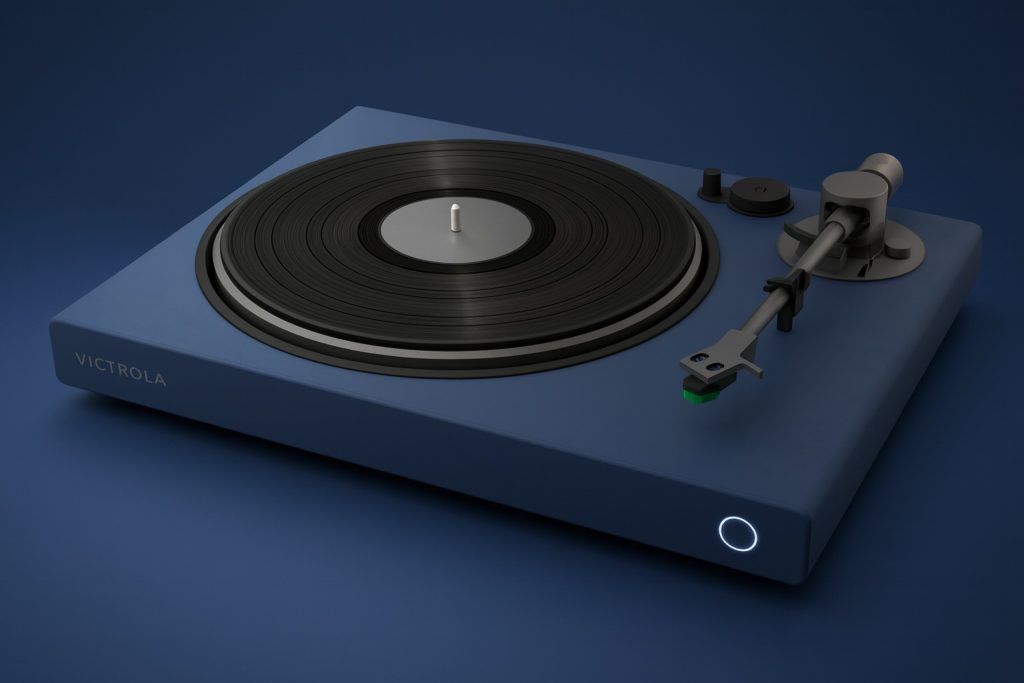Key Facts
- Limited Edition & Price: Audioengine’s A2+ in Matte Green is a special 2025 “Color of the Year” release, sold in very limited quantities. It’s priced at $279 – the same as the standard A2+ in black, white, or red [1]. Once this Matte Green run sells out, Audioengine says it “will not return”, so availability is fleeting [2].
- Next-Gen Upgrades: The A2+ received a “Next Gen” refresh for 2025, adding Bluetooth 5.3 wireless (with aptX-HD support), an upgraded 24-bit DAC, and a modern USB-C audio input – all while keeping the price under $300 [3]. These improvements deliver higher-resolution audio (up from the previous 16-bit limit) and easier hookup to new laptops and devices.
- Specifications: Each A2+ speaker houses a 2.75″ aramid fiber woofer and a 0.75″ silk dome tweeter, powered by a dual Class A/B amplifier (15 W RMS per channel, 60 W peak total) [4] [5]. The compact cabinets are front-ported for bass and hand-finished in a 13-step paint process. Inputs include Bluetooth, USB-C, a 3.5 mm aux, and RCA, plus a variable RCA output for an optional subwoofer [6] [7]. Frequency response is rated down to ~65 Hz, so adding a sub is beneficial for deep bass.
- Sound Quality: Despite their small size (~6″ tall), A2+ speakers are acclaimed for clear, full sound with excellent stereo imaging and detail. The sound signature is warm yet crisp, making music enjoyable and non-fatiguing [8]. TechRadar notes the A2+ are “easy to listen to” with “plenty of fine detail and premium build quality”, ideal for close-up listening in a small room or desk [9]. However, like any mini speaker, deep bass and room-shaking volume are limited – bass lovers may want to add a subwoofer for the lowest frequencies [10] [11].
- Expert Praise: The A2+ has been a top pick in the desktop speaker category for years. Sound & Vision lauded it for combining “audiophile-friendly sound with the convenience of Bluetooth” in a compact package [12]. Reviewers frequently mention its punchy, rich sound that exceeds expectations for its size and price. Twittering Machines, for example, called the A2+ “little treasures of sound that offer more than you’d expect given their price and size” [13]. Its solid MDF build and refined tuning give it an edge in sound quality over many plastic PC speakers.
- Comparisons: Within Audioengine’s own lineup, the A2+ sits above the smaller A1 and just below the pricier HD3. The HD3 uses the same drivers and 60 W amp as the A2+ and sounds nearly identical, but adds premium wood veneer options, removable magnetic grilles, and a built-in headphone amp (hence its higher ~$349 price) [14]. The larger Audioengine HD4 looks similar but offers roughly double the power (120 W peak) from bigger drivers, yielding stronger bass for ~$429 [15]. Audioengine’s classic A5+ and flagship HD6 are bigger bookshelf models intended for room listening, not just near-field – they deliver much deeper bass and higher volume, but at a higher cost and footprint.
- Vs. Competitors: In the $200–$300 range, the A2+ competes with popular powered speakers like the Kanto YU2/YU4 and various Edifier models. The Kanto YU2 ( ~$239) is another tiny desktop speaker, but lacks Bluetooth and relies on a Class D amp – it offers surprising bass for its size but isn’t as smooth or robust-sounding as the A2+, which reviewers find “richer and more harmonized” in sound quality [16]. Edifier’s budget speakers (e.g. R1280DB or R1700BT in the ~$150 range) provide decent value with larger cabinets and often built-in tone controls, but they “lack the A2+’s premium finish and clarity” and don’t match the Audioengine’s refinement (or its connectivity options like USB DAC) [17] [18]. For those seeking even higher performance, the Vanatoo Transparent Zero (around $399) is often cited as a step up – it’s a slightly larger mini-speaker with DSP and passive radiators for genuinely deeper bass – but at a higher price point and less aesthetic appeal for some. Overall, the A2+ hits a sweet spot of price, sound, and features that’s kept it at the top of many “best desktop speakers” lists.
- Latest News (2025): Audioengine has been busy this year with product launches and special editions. The Matte Green A2+ was introduced as the 2025 Color of the Year in March [19], and it follows last year’s Matte Blue edition. In mid-2025, to celebrate Audioengine’s 20th anniversary, the company even released an A2+ Next Gen Anniversary Edition in Matte Orange (limited to 250 numbered units) [20] – essentially the same speaker in a bold orange finish for collectors. On the product front, Audioengine rolled out “Next Gen” updates to its larger models: the HD4 Next Gen gained Bluetooth 5.3, aptX Adaptive and USB-C in April 2025 [21], and the HD3 Next Gen received the 24-bit DAC and USB-C upgrade in August 2025 [22] [23]. This refresh strategy shows Audioengine aligning its whole lineup with modern specs while retaining their classic designs. Meanwhile, competitors have launched new offerings in 2025 as well – for example, Onkyo (a veteran hi-fi brand) entered the desktop speaker arena with its GX-10DB ($199) and GX-30ARC ($299) models, which were unveiled at CES and target the same price bracket [24]. Kanto Audio introduced the ORA and ORA 4 desktop speakers, aiming for “reference” sound: the smaller ORA (~$349) packs 100 W of bi-amplified power and even includes a subwoofer output, positioning itself as a higher-end alternative for gamers and creators [25]. All this activity underscores that the premium desktop speaker market is hot in 2025, but the Audioengine A2+ – especially in its head-turning Matte Green finish – remains one of the most compelling choices for audiophiles and casual listeners alike.
Availability and Pricing
The Audioengine A2+ (Matte Green) is available as of 2025, but in extremely limited supply. Audioengine designated this color as its “2025 Color of the Year” and produced only a one-time batch [26] [27]. According to the company, Matte Green units are being sold directly on Audioengine’s website and through select retailers (for example, B&H Photo and Amazon have stocked it) [28] [29]. Importantly, the price remains $279 – Audioengine did not charge a premium for the special color; it costs the same as the standard A2+ in Matte Black, Glossy White, or Red [30]. This price includes the pair of powered speakers and necessary cables.
Because of the limited nature, interested buyers should act fast – Audioengine has stated that once the Matte Green edition sells out, “they will not return” [31]. As of the latest updates, the Matte Green A2+ is in stock at major retailers at $279 [32], but that could change quickly as supplies diminish. (For reference, the standard A2+ colors are regularly available and also list for ~$269–$279 depending on the retailer. We’ve seen minor discounts – e.g. around $265 at some stores – but generally the A2+ holds its price in the high-$200 range [33].)
It’s worth noting that Audioengine includes a 3-year warranty on these speakers and a 30-day audition/return period when purchased from authorized sellers, which adds confidence despite buying online. Some retailers also bundle the A2+ with accessories; for example, Amazon has offered a Matte Green bundle with the Audioengine DS1M metal desktop stands (angled risers that improve positioning) for a combined ~$318 [34]. Those stands normally cost ~$39 and are a popular add-on to get the best performance, as they tilt the speakers upward toward the listener’s ears.
In summary, the Matte Green A2+ is available now (as of late 2025) for $279, but only until existing stock runs out. If you prefer a different look or miss the green version, the A2+ is also sold in Matte Black or Matte Blue, or high-gloss White or Red finishes – and all of them carry that same MSRP of $279. Regardless of color, you’re getting the updated “Next Gen” hardware under the hood with the latest features.
Key Specifications and Features
Despite its compact dimensions, the Audioengine A2+ packs a lot of technology and thoughtful engineering aimed at audiophiles and casual listeners alike:
- Drivers: Each speaker contains a 2.75-inch aramid fiber woofer (for midrange and bass) and a 0.75-inch (3/4″) silk-dome tweeter for the highs [35]. These are the same high-quality drivers used in Audioengine’s more expensive models (like the HD3). The woofer cones are made of woven aramid fiber (similar to Kevlar), which is light and stiff, and the silk tweeters are fluid-cooled to handle power and provide smooth treble response [36].
- Amplification: The A2+ is a powered speaker system, meaning it has built-in amplification. It uses a dual Class A/B amplifier housed in the left speaker to drive both channels [37]. Class A/B amps are known for low distortion and high sound quality (as opposed to cheaper Class D amps in many competitors). The amp outputs 15 W RMS per channel (continuous), with 30 W peak per channel, for a total of 60 W peak power for the system [38]. This is plenty to fill a bedroom, office, or small studio with sound. Users report that the A2+ can play surprisingly loud for its size, while maintaining clarity.
- DAC and Inputs: One highlight of the A2+ (especially the updated Next Gen model) is its built-in DAC (digital-to-analog converter) which now supports 24-bit/96 kHz audio via the USB-C input [39] [40]. This means you can connect the A2+ directly to a computer’s USB port and bypass the computer’s sound card, allowing for high-resolution playback (up to 24-bit, whereas the previous A2+ was limited to 16-bit USB audio). In practice, this can yield slightly cleaner and more detailed sound when playing lossless music. In addition to USB-C, the A2+ offers dual analog inputs: a standard 3.5 mm stereo mini-jack (for connecting devices like phones, laptops, Echo Dots, etc. via their headphone jack) and a pair of RCA inputs (useful for a turntable with a phono preamp, or any CD player, DAC, etc.) [41] [42]. All three inputs are live and auto-sensing, meaning you don’t have to manually switch sources – you can have multiple devices connected and the speakers will play whichever source is active.
- Wireless Connectivity: The Next Gen A2+ features Bluetooth 5.3 with support for aptX-HD codec [43] [44]. Bluetooth aptX-HD allows for streaming of high-quality audio (24-bit) with lower latency, as long as your phone or computer also supports aptX or aptX-HD. It’s backwards-compatible with standard Bluetooth (SBC and AAC codecs), so any device can stream to the speakers wirelessly [45]. The wireless range is rated up to 100 ft under ideal conditions [46], which is quite generous – in a typical home you can easily roam to an adjacent room with your phone. This makes the A2+ a convenient all-in-one music system: you can play from Spotify, Apple Music, etc., without any cables, or even use them as TV speakers via Bluetooth (with aptX’s low latency helping keep audio in sync).
- Outputs and Expandability: On the back of the left speaker, there’s an RCA variable output [47]. This is essentially a subwoofer output – it lets you send low-frequency audio to a powered subwoofer, and its level will track the A2+’s volume knob. Audioengine sells a companion subwoofer (the S8) but any sub with RCA line-in will work. This output can also feed another device like an external amp or headphone amp if needed. The A2+’s ability to add a sub is important, since its small drivers naturally roll off around 65 Hz (in real-world use, you get some bass but not the chest-thumping kind). If you desire a fuller range for movies or bass-heavy music, you can complement the A2+ with a sub to cover, say, 30–80 Hz. (The speakers themselves have a front slot-ported cabinet design to enhance bass in the 65–200 Hz range without distortion [48] [49], and they do well for their size, but physics is physics – a 2.75″ woofer can only move so much air.)
- Build and Design: Aesthetically, the A2+ are known for their clean, modern design. The cabinets are made of 18 mm thick MDF wood, which helps reduce resonance [50]. Audioengine hand-finishes them in various colors; the Matte Green in particular has a satin sheen that’s less flashy than gloss, fitting nicely with home decor. The speakers measure 6″ H x 4″ W x 5.25″ D (152 × 101 × 134 mm) each [51] – roughly the size of a thick hardcover book – and weigh about 3.5 lbs each. The left speaker’s back panel has the volume/power knob and all connections (RCA in/out, USB, power input, Bluetooth pairing button, etc.), while the right speaker is passive and simply connects via speaker wire to the left. Audioengine includes a high-quality speaker cable in the box to link the pair [52]. Notably, the cabinet finish is high-end: the company uses a multi-step painting and sanding process (13 coats, similar to a piano finish) for durability and a luxe look [53] [54]. Even the feel of the knobs and connectors is solid, reflecting Audioengine’s attention to quality.
- Ease of Setup: Getting the A2+ up and running is very straightforward – one reason these speakers are often recommended for those who want better sound with minimal fuss. There’s no app or network setup needed (these aren’t Wi-Fi or smart speakers, which some might see as a plus for simplicity and longevity). You just plug the left speaker into power, connect the right speaker with the provided cable, and then you can either pair via Bluetooth (press the pair button on back, connect from your phone/computer) or plug into one of the analog/USB inputs. Many users appreciate this plug-and-play design [55] – there are no complex menus or firmware updates to worry about. The volume can be adjusted either via the knob on the speaker or by your source device’s volume (when using USB or Bluetooth, the source can control volume digitally). The speakers will remember paired Bluetooth devices and auto-connect to the last used device when you power them on, adding to the convenience.
- Power Saving: The A2+ uses traditional analog amplification (Class A/B), which some audiophiles prefer for its sound, but it can draw more power and run warmer than Class D amps. That said, Audioengine has implemented circuit designs to keep the system efficient. There’s no auto-standby (the speakers stay on until you turn them off), but at idle they consume very little power. The external power adapter (a small brick) supplies 15 V DC to the left speaker; having it external helps keep heat and noise out of the speaker cabinet. Audioengine mentions that all the electronics are on vertically oriented circuit boards inside to protect against vibration [56]. In practice, the A2+ are reliable – many owners use them daily for years without issues, and the 3-year warranty backs that up.
Feature Highlights (Recap): The refreshed A2+ offers wide connectivity (wireless, USB, analog), an audiophile-grade 24-bit DAC, a robust 60 W amplifier, and proven Audioengine sound quality in a compact form. It’s this blend of hi-fi principles with plug-and-play usability that makes the A2+ stand out. Whether you connect a turntable (via a phono preamp), stream lossless music from a PC, or just play Spotify from your phone, the A2+ can handle it. Its size makes it perfect for a desktop, credenza, or dorm room, and the variety of color finishes – especially eye-catching limited editions like Matte Green – mean it can look as good as it sounds.
Performance and Expert Reviews
The Audioengine A2+ has garnered strong reviews across the board, ever since the original version launched years ago and continuing through this latest iteration. Here we’ll summarize some expert opinions and real-world performance observations:
- Sound Signature: Reviewers consistently note that the A2+ produces a remarkably full and balanced sound for a speaker of its size. It’s voiced on the warm and smooth side of neutral, which means music and even movies sound rich and inviting rather than analytical. In Sound & Vision’s tests, the A2+’s sound was described as “warm and inviting, yet clear,” making it especially good for acoustic music and vocals [57]. High frequencies (treble) are detailed but not harsh – the silk dome tweeters give a bit of a “soft” top end, avoiding the edgy or metallic treble that some cheap speakers exhibit. The midrange (where vocals, guitars, etc. lie) is a standout: natural and present. Steve May of TechRadar was impressed by the stereo imaging and detail from the A2+, noting that these mini speakers can throw a surprisingly wide soundstage that “spreads wide across the desk” and even has some depth [58] [59]. Instruments and voices are well-separated, which is great for near-field listening – you can pick out details in well-recorded tracks.
- Bass Response: Let’s address the bass, as that’s often a concern with small speakers. The A2+ are bass-ported and tuned to play down to ~65 Hz (±2 dB) [60]. In practical terms, they deliver a satisfying punch and “thump” on kick drums, bass guitars, and synths within their range. Many reviews mention that on a desktop, the speakers benefit from boundary gain – placing them on a desk or near a wall can reinforce the low-end. Twittering Machines’ reviewer actually preferred the sound of the A2+ sitting on the desk surface (without stands) for a “fuller” bass response, noting it gave a pleasantly “plump” character to the music [61]. That said, the laws of physics apply: below 60 Hz or so, these can’t produce much output. In direct A/B comparisons with larger speakers or with a subwoofer added, you’ll notice the missing deep bass. TechRadar’s verdict bluntly states “No deep bass to speak of” as a con [62] – bass addicts will indeed want a sub. But within moderate listening levels, most users find the bass tight and well-balanced, not bloated. The lack of artificial bass-boost DSP (which some competing speakers use) means the A2+ doesn’t exaggerate bass it can’t cleanly produce – an approach that earned praise from APH Networks, which found the A2+ tuning more prudent than a rival that tried to overextend its bass and caused distortion [63] [64].
- Volume and Dynamics: The A2+ can play surprisingly loud for near-field speakers. With 15 W RMS per channel, they handle typical desktop use (2–3 feet from the listener) with ease, and can fill a small room at moderate volume. One thing to keep in mind: being small speakers, they have limits in terms of maximum volume and dynamic headroom. Pushing them to their top volume in a larger space can result in some compression or congestion in complex music passages [65]. For instance, in orchestral music played loudly, a reviewer noted the sound “could get a bit congested at high volumes” [66]. This is expected for a speaker with tiny woofers. Within normal listening levels, though, the clarity is excellent. The Class A/B amp ensures that at low to mid volumes the distortion remains very low (under 0.05% THD+N) [67] [68]. There’s no hiss or hum when nothing’s playing – the speakers are quiet in standby, which is important for desktop use.
- Comparisons in Sound Quality: Many experts have compared the A2+ to other speakers in its class during reviews. A common point of comparison is the Kanto YU2 (another 2.0 desktop speaker set with 3″ woofers). In a detailed head-to-head analysis, APH Networks concluded that the A2+ sounded more refined, saying “the Kanto YU2 is not as rich and harmonized as the Audioengine, which is the A2+’s strong point” [69]. The A2+’s wooden enclosure and analog amp likely contribute to this perceived richness. Against the slightly larger Edifier R1280DB (which has a 4″ woofer but is tuned for more mid-bass), listeners often find the Audioengines deliver cleaner, less muddy bass and better treble clarity. One Reddit user who auditioned both said the A2+ simply “sound far richer” than the Edifiers [70]. The trade-off is that something like Edifier’s speakers, or the popular Klipsch ProMedia 2.1, can go louder or lower with a sub; but for pure audio fidelity in near-field, the A2+ holds an edge.
- Build and Aesthetics Feedback: Reviewers also comment on the build quality and appearance, which add to the overall experience of owning the A2+. Many love the minimalist design – no flashing LEDs or cheap plastic here. The Matte Green finish in particular got rave remarks for being unique and “pretty stylish” [71] [72]. Gear Patrol’s write-up on the Matte Green edition noted that Audioengine’s special color releases “reflect their commitment to sound and style”, catering to listeners who want gear that looks as good as it sounds [73] [74]. The small form factor is another plus: these speakers don’t dominate the desk. At roughly 6 inches tall, they can flank a laptop or monitor easily, and with the optional angled stands, they integrate neatly into a workspace setup. Several reviewers have mentioned the A2+ are “desk-friendly” and compact enough for tight setups [75]. The left speaker’s front volume knob is on the back (by design, to keep the front clean-looking), which is one minor inconvenience noted – reaching behind to adjust volume if you don’t use your source’s volume control. However, most get around this by setting the speaker volume at about 11 o’clock position and then using the computer/phone volume for daily adjustments.
- Use Cases: In terms of usage, experts and users have tried the A2+ in various scenarios. Commonly, they are praised as computer speakers – whether for music while working, streaming videos, or gaming, they offer a huge upgrade over built-in monitor speakers or cheap USB speakers. Their imaging and clarity also make them great for near-field gaming (you can pinpoint sounds in the stereo field). They are also popular for small turntable setups – pair the A2+ with a budget turntable + phono preamp and you have a neat vinyl listening station. The analog input handles the turntable output nicely, and the sound character (slightly warm) complements vinyl. Additionally, some use the A2+ as TV speakers in a bedroom or dorm, via Bluetooth or the 3.5mm out of a TV – they won’t mimic a full soundbar with sub, but they will be clearer than TV speakers for dialogue and casual viewing. The versatility is a big selling point: you can easily move these from the office to a den or take them to a friend’s place if needed, since they’re small and only require plugging into an outlet and source.
- Notable Quotes: To encapsulate the critical reception, here are a few choice quotes from expert reviews:
- “The A2+ combines audiophile-friendly sound with the convenience of Bluetooth to create a broadly appealing compact speaker package.” – Sound & Vision [76]
- “Offering pronounced stereo imaging, plenty of fine detail, and premium build quality, these versatile speakers are well worth a look when space is limited.” – TechRadar (Verdict) [77]
- “These little speakers also do a fine job of disappearing, throwing out a much larger-than-their-size sound image.” – Twittering Machines (on the A2+ soundstage) [78]
- “Very easy to like… they sound amazing given the size!” – Customer review (Audioengine site) [79].
Overall, the consensus is that Audioengine hit a home run with the A2+. They deliver on sound quality, have the latest connectivity built-in, and come in a stylish package. While they’re not the cheapest speakers out there, reviewers often emphasize that value for money is excellent – you’d be hard-pressed to find another speaker at ~$279 that offers the same refinement. Many competing speakers either skimp on the DAC, the amp quality, or the cabinet finish to hit lower price points, whereas Audioengine balanced these aspects nicely. The Matte Green edition simply adds a bit of exclusivity and personalization to an already highly-rated product.
Comparisons: Audioengine Lineup & Competing Speakers
To understand where the A2+ stands, it’s helpful to compare it both to other models in Audioengine’s range and to key competitors in the desktop speaker market.
Within Audioengine’s Lineup
Audioengine currently offers multiple powered speaker models. Here’s how the A2+ (aka the Audioengine 2+ Home Music System) stacks up:
- Audioengine A1 – The A1 is like the little brother to the A2+. It’s a slightly smaller, more affordable model (around $199). The A1 has a similar 2.75″ woofer but a simpler design: it offers Bluetooth and analog inputs, but no USB DAC. Power is a bit lower (around 25 W peak per channel). Essentially, the A1 is aimed at budget buyers, whereas the A2+ steps up the audio quality and input options. If the A2+ is a “best bang for buck,” the A1 is “bang for less buck.” However, since the A1 lacks the RCA outputs and 24-bit DAC, many enthusiasts find the A2+ worth the extra cost.
- Audioengine A2+ (Next Gen) – [Our star of the show.] This sits in the lower-middle of the lineup price-wise, but punches above its weight in performance. It’s considered an evolution of the original Audioengine 2 (A2) that launched back in 2007 [80]. Audioengine has kept the same form factor and core design, while adding features like Bluetooth and upgrading components over time. With the 2025 Next Gen refresh, the A2+ is very up-to-date. It’s positioned as the go-to desktop speaker solution for most people.
- Audioengine HD3 – The HD3 is a slightly more expensive model (MSRP ~$349). It actually has the same footprint and driver size as the A2+ (2.75″ woofer, 0.75″ tweeter) [81], and after the 2025 update, it too has a 24-bit DAC, Bluetooth 5.3, and USB-C. So what do you get for the extra ~$80? Mainly: premium materials and extra features. The HD3 cabinets come in real wood veneers (like walnut) or high-gloss lacquer, and they include magnetic speaker grills for a more traditional hi-fi look (the A2+ drivers are exposed). The HD3 also has a built-in headphone amplifier with a front headphone jack [82] [83] – a nod to audiophiles who want a one-stop desktop system for both speakers and headphones. Sound-wise, Audioengine says the HD3 and A2+ are almost identical in performance [84]. Gear Patrol notes “in terms of size and sound quality, the HD3 and the A2+ are basically the same”, with the differences being aesthetics and that headphone amp [85]. So the HD3 is for those who want a slightly more luxe build and the flexibility of a high-quality headphone output.
- Audioengine HD4 – Step up to the HD4 (around $429), and you get a larger speaker physically. The HD4 has 4″ aramid fiber woofers and is about 25% taller/bigger in volume. The 2025 HD4 Next Gen also has Bluetooth 5.3+aptX Adaptive and USB-C now [86]. The key benefit of the HD4 is more power (approx. 50 W RMS per channel, 120 W peak) and deeper bass extension. According to Audioengine, the HD4 can reach into the mid-50 Hz range before roll-off, and subjectively it can fill a larger room more easily than the A2+ or HD3. However, it’s also nearly twice the size, so on a small desk it might be imposing. Gear Patrol summarized it well: the HD4 is “identical in terms of look and features [to the HD3], but… larger, twice as powerful, and delivers noticeably deeper bass.” [87] If you have the space and budget, the HD4 is the more room-capable speaker, whereas the A2+ is still king for tight setups.
- Audioengine A5+ / HD6 – These are the bigger bookshelf models (A5+ around $399–$499 depending on variant, and HD6 at $699). The A5+ has been around for a while as a larger 5″ woofer model. It’s great for medium-sized rooms and has optional add-ons like a subwoofer output (the latest A5+ includes Bluetooth as well). The HD6 is the flagship with 5.5″ Kevlar woofers, built-in aptX HD Bluetooth and a 24-bit DAC (it essentially predicted the features now trickling down to the smaller models). The HD6 is known for its beautiful build (hand-built wood cabinets) and big, audiophile sound that can compete with passive bookshelf speakers. However, both A5+ and HD6 are more bookshelf or living room speakers than desktop speakers – they physically take up much more space. If one has room on a large desk or wants speakers that can double for a bedroom hi-fi, they might consider these, but for most near-field listeners the A2+ hits a sweet spot of size vs performance.
In short, Audioengine’s strategy has been to take the proven formula of the A2 and scale it up or enhance it for different use cases. The A2+ (Next Gen) remains the core recommendation for desktop use, while the HD3 adds some bells and whistles, and the HD4/HD6 take the performance further for those needing more output. Notably, all these models share a similar “family sound” – warm, musical, and non-fatiguing. If you like the A2+ sound but need more oomph, you can move up the line confidently.
Competing Desktop Speakers
The marketplace for powered desktop speakers has grown, and by 2025 there are several compelling alternatives. Here we compare a few notable ones to the Audioengine A2+:
- Kanto YU2 / YU4 / ORA: Kanto is a Canadian brand that has gained popularity in the desktop speaker scene. The YU2 (approx. $219–$249) is very close in concept to the A2+: a tiny 2.0 set with 3″ woofer and 3/4″ tweeter. It even comes in fun colors. The YU2, however, does not include Bluetooth or a built-in DAC – it’s analog-only (3.5mm and USB audio pass-through for PC). It uses a Class D amp rated at 50 W peak per channel. In reviews, the YU2 is often compared to the A2+. It actually can produce slightly more bass at the extreme low-end (Kanto tuned it to eke out a bit of 50–60 Hz with a steep drop-off), but this comes at the cost of distortion at high bass levels [88] [89]. The A2+ in contrast doesn’t try to over-boost the bass beyond its comfort zone, resulting in cleaner sound. Overall, the A2+ is considered the better-sounding and better-featured choice if budget allows, whereas the YU2 is a decent lower-cost pick. Kanto’s YU4 ($329) and YU6 ($499) are larger speakers (with 4″ and 5.25″ woofers respectively) that include features like Bluetooth, a remote, and even a phono preamp (in YU4/YU6). Those compete more with Audioengine’s HD4 and A5+ perhaps. For the scope of small desktop units, Kanto recently released the ORA series (mentioned in the news section): The Kanto ORA (~$349) is a premium 3″ driver speaker with a built-in DSP and more powerful amplification. It’s positioned a bit above the A2+ in price. According to press info, ORA is targeting a more studio-monitor-like sound in a compact form, with 100 W total Class-D power and very deep bass response for its size [90]. The ORA 4 is a 4″ version for those wanting a larger speaker. While ORA’s price is higher, it’s an indicator that manufacturers are recognizing demand for high-quality desktop speakers. Audioengine’s A2+ still competes well here – it has the advantage of a longer track record and the nuanced tuning of Class A/B, whereas ORA emphasizes raw power and DSP correction.
- Edifier Powered Speakers: Edifier offers numerous models, often at budget-friendly prices. A common comparison is the Edifier R1280DB/R1280T (these are ~$130-$150 2.0 speakers with 4″ woofers). Those are significantly cheaper than A2+, and you do get more bass simply from the larger woofer and cabinet. They even include a remote and tone controls. However, the clarity and stereo imaging of the Edifiers are generally a step down from the A2+. They are great for general use or TV, but audio enthusiasts often find them a bit muddy in the midrange and not as detailed in treble. Edifier also has mid-range offerings like the S1000MKII ($400) or S2000Pro ($450) which have higher-end drivers and tweeters; those can actually compete well in sound quality, but they are much larger bookshelf speakers (and more expensive). In the small form factor category, Edifier’s MR4 (a $150 2.0 “monitor”) and G2000 ($100 gaming speakers) are often mentioned – again, none quite match the overall refinement of the A2+, but they undercut it in price. So if one’s budget is tight, Edifier is a go-to, but if sound-per-dollar is the metric, the A2+ holds its own because it sounds like a more expensive unit.
- Vanatoo Transparent Zero (T0): This is an interesting one because Vanatoo (a niche audiophile brand) specifically targets the desktop audiophile crowd. The Transparent Zero originally launched around $359 (the newer “Zero Plus” is ~$399). These are slightly larger speakers (with passive radiators) and they employ a lot of DSP trickery to produce an incredibly flat and extended frequency response for a tiny speaker – they can reach down to near 50 Hz with usable output, and have adjustable EQ switches. They also have an integrated DAC, Bluetooth, and even an optical input. Sound-wise, many who have auditioned the Vanatoo T0 vs Audioengine A2+ will concede the Vanatoo can deliver deeper bass and more output – essentially it sounds like a bigger system. For example, one Head-Fi user stated the Transparent Zero is “much better than the Audioengine A2+” for pure performance [91]. The downsides: Vanatoo’s design is utilitarian (plain black boxy cabinets) and they are less readily available (often backordered due to small production runs). They’re also more expensive. So while the Vanatoo T0 might be the sound quality king of the micro-speaker niche, the A2+ wins in looks and is more widely appreciated for day-to-day listening (some find Vanatoo’s sound a bit too analytically tuned for casual listening).
- Onkyo GX-10DB / GX-30ARC: Newly released in 2025, these Onkyo models are the brand’s attempt to enter the PC speaker space [92] [93]. The GX-10DB ($199) and GX-30ARC ($299) are priced bracketing the A2+. Onkyo’s approach is interesting: the GX-30ARC (the $299 model) includes an HDMI-ARC input, targeting use with TVs or monitors, and Bluetooth 5.3. It’s a slightly larger speaker (with a 4″ woofer) and even comes with a wireless remote, making it more of a hybrid between desktop and bookshelf system. We don’t have extensive reviews yet, but Onkyo’s pedigree in audio means these could be strong contenders. Still, as a first-gen product in this segment for Onkyo, they lack the proven track record of the A2+. The A2+ might still be the safer pick for now, but it’s great to see more brands recognizing the demand here.
- Others: Other competitors include the Klipsch ProMedia 2.1 (a classic 2.1 set around $130, great for games and movies with its subwoofer, but not as refined in mids/highs), Bose Companion series (not known for accuracy, but user-friendly), and studio monitor pairs like Presonus Eris or KRK Rokit 4. The studio monitors can offer very neutral sound and good value, but typically lack the convenient features (no Bluetooth/DAC, need an audio interface or volume knob). For example, a pair of IK Multimedia iLoud Micro Monitors (~$350) are often praised – they are very small like A2+ and aimed at musicians, with exceptionally flat response and in-built DSP. Those actually challenge the A2+ on audio accuracy, but again, they look more utilitarian and are designed for near-field only.
When comparing, it’s clear the Audioengine A2+ occupies a sweet middle ground. It’s not the absolute cheapest, nor the most expensive or highest-spec; instead, it balances sound quality, build quality, and features in a way that few others do at this size. This is why the A2+ often comes out on top in comparisons – it’s an “all-rounder” that satisfies both tech spec geeks (with its aptX HD, 24-bit DAC, etc.) and everyday users (with its ease of use and pleasing sound). As one Redditor succinctly put it in a debate between options: “It seems clear that the [Vanatoo] T0 are the best speakers overall, but the A2+ are the best package for the price”. This sentiment reflects how the A2+ has become a benchmark for small powered speakers.
New and Upcoming Speakers (Audioengine & Competitors)
The landscape in 2025 shows a lot of movement – Audioengine and its competitors are releasing updates and new models to capture the interest of audio enthusiasts. Here are some notable news and upcoming releases related to the A2+ and its peers:
- Audioengine “Color of the Year” Editions: Audioengine has established a tradition of launching limited-edition colors for their products. In 2024, they offered a Matte Blue version of the A2+; for 2025, Matte Green took the crown as the Color of the Year [94] [95]. The company stated this program “reflects our commitment to creating Home Music Systems that not only sound incredible but also enhance the visual appeal of any space” [96]. The enthusiastic response to these colors indicates that there’s a market for audio gear that doubles as decor or personal style statement. The Matte Green A2+ was announced in early March 2025 and, as detailed, quickly became a hot item for Audioengine fans. Following that, in July 2025, Audioengine celebrated its 20th anniversary (the brand was founded around 2005) by releasing an Anniversary Edition A2+ in Matte Orange [97]. Only 250 units of the orange variant were made, each individually numbered and signed by the founders [98]. While functionally identical to the A2+ Next Gen, it came in special packaging and is a collector’s piece (essentially “a fresh coat of traffic-cone flair,” as one tongue-in-cheek article put it [99]). These limited colors tend to sell out fast, but they create buzz and show Audioengine having fun with their designs.
- Next Gen Upgrades Across the Line: The A2+ wasn’t the only model to get love in 2025. In May 2025, Audioengine launched the HD4 Next Gen [100]. The HD4 was originally introduced a couple years prior as a midway between desktop and bookshelf speaker, and the Next Gen update gave it Bluetooth 5.3 with aptX Adaptive (Adaptive is the newer codec that adjusts quality based on connection) and USB-C connectivity, similar to the A2+ update [101]. The HD4’s price remained around $429, making it a compelling option for those wanting more bass/output than the A2+. Then in August 2025, the HD3 Next Gen was released [102] [103]. This completed the trifecta of updates: A2+, HD3, HD4 all with modern inputs and high-res DACs. The HD3 Next Gen kept its price at ~$359 and came out in three finishes (Satin Black, Walnut, and Piano White) [104]. Audioengine’s approach has been evolutionary – these “Next Gen” models look the same externally as before, ensuring accessories (stands, etc.) still fit, but they bring the internals up to date. It’s also worth noting Audioengine updated some of their wireless adapters: for instance, they announced a B1 Bluetooth Receiver Next Gen in Jan 2025 with aptX Adaptive support [105] – this isn’t a speaker, but it shows the brand’s commitment to the latest Bluetooth tech across their product range.
- Competitor Releases: Several competitors made headlines with new desktop speakers around 2024–2025:
- Kanto ORA & ORA 4: As discussed, Kanto’s new ORA series was showcased at the Munich High End audio show in May 2025 [106]. The standard ORA is a compact speaker positioned similarly to Audioengine’s HD3/A2+, but with a higher power output and an emphasis on “studio-grade sound” [107]. It has features like a socket for an optional subwoofer (just like Audioengine’s RCA out) and comes with optional custom desktop stands [108] [109]. The larger ORA 4 extends that concept with a 4″ woofer for bigger sound. Kanto also introduced Uki (a very affordable $199 mini speaker system with true wireless stereo) and Ren (a higher-end $599 speaker with HDMI-ARC) [110] [111], showing a broad push into various price tiers. The ORA at $349 does challenge the A2+ from above – initial impressions from audio communities suggest the ORA has great clarity and bass for its size, but whether it unseats the A2+ in popularity will depend on consumer taste (and it being $70 more).
- Onkyo’s Creator Series: Onkyo surprised many by launching the GX-10DB and GX-30ARC in early 2025 [112] [113]. These are noteworthy because Onkyo is a long-established Japanese hi-fi firm, but they hadn’t produced computer speakers under their name in years (their home theater division had gone through changes). The Creator series is aimed at content creators and everyday users wanting good sound for their desks. The GX-10DB is the smaller model (3″ woofer, likely similar in spec to A2+) at $199, and the GX-30ARC has a 4″ woofer plus an HDMI-ARC input at $299 [114]. Both were set to ship by March 2025 [115]. Reviews are still coming in, but having HDMI could be a differentiator for those who want a versatile speaker for both PC and TV. For pure audio, we’ll have to see if Onkyo’s tuning matches the finesse of Audioengine’s (which has evolved over 15+ years of the A2 lineage). Still, it’s an exciting development, indicating mainstream audio companies see value in the desktop audio segment – a win for consumers.
- Other Hi-Fi Brands: Another trend is traditional hi-fi brands trying their hand at desktop speakers or all-in-one systems. For instance, Klipsch partnered with Onkyo’s parent company and has some stake in those products. KEF released the second-gen KEF LSX II (a wireless hi-fi speaker pair, albeit at ~$1400, much higher-end) in 2022 and continues to market it in 2025 as a premium desktop or bookshelf solution. Edifier launched a spin-off brand called Airpulse (with designs by Phil Jones) that makes higher-end desktop speakers like the A100 ($799). And even Bose introduced the Companion 50 and others in recent years to update their aging PC speaker line. None of these directly threaten the niche the A2+ sits in (either they’re too high-end, or too mass-market with not as much hi-fi cred), but it shows a converging trend: people are investing in better speakers for personal listening, whether at the computer, in a home office, or a small living space.
- Potential Upcoming Models: Looking ahead, one could speculate that Audioengine might eventually update the A5+ or HD6 with newer wireless tech (aptX Adaptive or Wi-Fi streaming perhaps) as those are now the only models without a “Next Gen” label. Also, given the success of the Color of the Year program, it’s likely we’ll see a 2026 Color of the Year edition – perhaps another bold hue – and possibly limited runs for other models (imagine an HD3 in a unique color, etc.). Audioengine has also expanded into accessories (like their USB DACs, wireless transmitters, and even headphones in the past), so any news on that front could tie into the ecosystem that the A2+ lives in.
In summary, 2025 has been a vibrant year for desktop audio. The Audioengine A2+ (Matte Green) sits at the intersection of many of these developments: it represents a perfected design that’s been lightly refreshed for modern needs, it capitalizes on the trend of aesthetic customization (limited colors), and it faces new rivals that keep pushing it to remain excellent. The good news for consumers is that there are more choices than ever – but the A2+ continues to earn its reputation as a top pick thanks to Audioengine’s consistency and the speaker’s own balanced performance.
Conclusion
The Audioengine A2+ (Matte Green) encapsulates what many of us want from desktop speakers in 2025: rich, high-fidelity sound; versatile connectivity; and a touch of personal style – all at a price that still feels like a solid investment in quality. Its limited-edition color appeal and the buzz surrounding it have only added to the A2+ legacy, but even stripped of the paint job, the underlying product is a standout in its category.
With the latest Next Gen upgrades, the A2+ can confidently interface with any modern setup – from wirelessly streaming your hi-res playlist over Bluetooth aptX-HD, to serving as a USB sound card for your computer, to being the audio hub for turntables and game consoles. Expert reviewers and everyday listeners alike commend its clarity, soundstage, and surprising bass for the size. While it’s not a window-rattling system (and wasn’t meant to be), it achieves that delicate balance where music is enjoyable and engaging without needing any tweaking or additional gear.
The Matte Green edition, in particular, shows Audioengine’s understanding that speakers are not just utilitarian boxes but can be part of your decor and self-expression. It’s a conversation piece – a bit of rarity that also happens to deliver great sound when you hit “Play”. And if green isn’t your thing, the A2+ is still available in classic finishes, or you can look out for whatever the next Color of the Year will be.
Competition is heating up, but Audioengine’s commitment to incremental improvement (as seen with the across-the-line Next Gen updates) means the A2+ holds its ground. New challengers like Kanto’s ORA or Onkyo’s GX series give buyers more to consider, yet the A2+ remains a benchmark for premium small speakers. It’s telling that even after nearly 18 years since the original A2’s debut, the core design is still relevant and receiving accolades [116] [117]. This speaks to Audioengine’s success in essentially defining this product category.
For anyone in the market for desktop speakers now, the Audioengine A2+ should be on your shortlist. And if you can snag a pair of the Matte Green limited edition, you’ll have something that not only elevates your audio experience but also stands out as uniquely yours. In the end, the A2+ Matte Green delivers substance with style – a combination that’s as rare in tech as a limited-run colorway.
Sources: The information in this report is based on expert reviews, product announcements, and official specifications from Audioengine and other credible outlets, including eCoustics [118] [119], Gear Patrol [120] [121], TechRadar [122], Sound & Vision [123], APH Networks [124], and Audioengine’s own releases [125] [126], among others. These sources have been cited throughout the text for reference.
References
1. www.gearpatrol.com, 2. www.gearpatrol.com, 3. www.ecoustics.com, 4. www.ecoustics.com, 5. www.bhphotovideo.com, 6. www.bhphotovideo.com, 7. www.amazon.com, 8. www.soundandvision.com, 9. www.techradar.com, 10. www.techradar.com, 11. www.techradar.com, 12. www.soundandvision.com, 13. twitteringmachines.com, 14. www.gearpatrol.com, 15. www.gearpatrol.com, 16. aphnetworks.com, 17. www.amazon.com, 18. www.amazon.com, 19. www.gearpatrol.com, 20. www.ecoustics.com, 21. gearspace.com, 22. www.gearpatrol.com, 23. www.gearpatrol.com, 24. www.gearpatrol.com, 25. press.starscreamcommunications.com, 26. www.gearpatrol.com, 27. www.gearpatrol.com, 28. www.gearpatrol.com, 29. www.gearpatrol.com, 30. www.gearpatrol.com, 31. www.gearpatrol.com, 32. www.bhphotovideo.com, 33. www.techradar.com, 34. www.amazon.com, 35. www.bhphotovideo.com, 36. www.bhphotovideo.com, 37. www.ecoustics.com, 38. www.ecoustics.com, 39. www.ecoustics.com, 40. www.ecoustics.com, 41. www.ecoustics.com, 42. www.bhphotovideo.com, 43. www.bhphotovideo.com, 44. www.bhphotovideo.com, 45. www.bhphotovideo.com, 46. www.bhphotovideo.com, 47. www.ecoustics.com, 48. www.soundandvision.com, 49. www.soundandvision.com, 50. twitteringmachines.com, 51. twitteringmachines.com, 52. twitteringmachines.com, 53. www.ecoustics.com, 54. www.ecoustics.com, 55. www.bhphotovideo.com, 56. www.bhphotovideo.com, 57. www.soundandvision.com, 58. www.soundandvision.com, 59. www.soundandvision.com, 60. twitteringmachines.com, 61. twitteringmachines.com, 62. www.techradar.com, 63. aphnetworks.com, 64. aphnetworks.com, 65. www.soundandvision.com, 66. www.soundandvision.com, 67. www.ecoustics.com, 68. www.ecoustics.com, 69. aphnetworks.com, 70. www.audiosciencereview.com, 71. www.gearpatrol.com, 72. www.gearpatrol.com, 73. www.gearpatrol.com, 74. www.gearpatrol.com, 75. www.techradar.com, 76. www.soundandvision.com, 77. www.techradar.com, 78. twitteringmachines.com, 79. audioengineeu.com, 80. www.ecoustics.com, 81. www.gearpatrol.com, 82. www.gearpatrol.com, 83. www.gearpatrol.com, 84. www.gearpatrol.com, 85. www.gearpatrol.com, 86. www.ecoustics.com, 87. www.gearpatrol.com, 88. aphnetworks.com, 89. aphnetworks.com, 90. www.amazon.com, 91. www.head-fi.org, 92. www.gearpatrol.com, 93. www.gearpatrol.com, 94. www.gearpatrol.com, 95. www.gearpatrol.com, 96. www.gearpatrol.com, 97. www.ecoustics.com, 98. www.ecoustics.com, 99. www.ecoustics.com, 100. www.gearpatrol.com, 101. gearspace.com, 102. www.gearpatrol.com, 103. www.gearpatrol.com, 104. www.gearpatrol.com, 105. audioengine.com, 106. press.starscreamcommunications.com, 107. www.kantoaudio.com, 108. press.starscreamcommunications.com, 109. press.starscreamcommunications.com, 110. press.starscreamcommunications.com, 111. press.starscreamcommunications.com, 112. www.gearpatrol.com, 113. www.gearpatrol.com, 114. www.gearpatrol.com, 115. www.gearpatrol.com, 116. www.ecoustics.com, 117. www.ecoustics.com, 118. www.ecoustics.com, 119. www.ecoustics.com, 120. www.gearpatrol.com, 121. www.gearpatrol.com, 122. www.techradar.com, 123. www.soundandvision.com, 124. aphnetworks.com, 125. www.ecoustics.com, 126. gearspace.com










